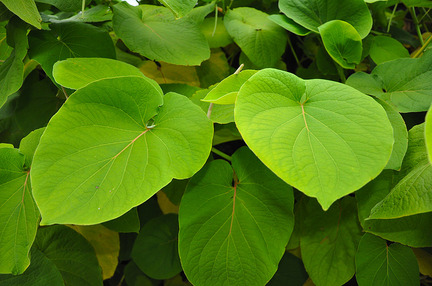Hoja santa (Piper auritum) is an aromatic herb with a large, heart-
shaped, velvety leaf which grows in the tropics of Latin America.
The name hoja santa means “sacred leaf” in Spanish, but it goes by
other monikers: acuyo, yerba santa, hierba santa, Mexican pepper-
leaf, root beer plant, and sacred pepper.
A Mexican legend says that the Virgin Mary dried diapers of the
infant Jesus on the branches of this plant, hence the name. Sounds
implausible to me, and diapers do not sanctify a plant in my book,
but stranger things have happened.
It is often used in Mexican cuisine, especially around Veracruz, as
a wrapper for cheeses, tamales, or for seasoned seafood, poultry, or
meats which are then steamed or baked; the leaf itself is not usually
eaten when used as a wrapper. It is mainly a flavoring agent that
is discarded after the filling is eaten.
It is an essential ingredient in mole verde and mole amarillo, green
and yellow seasoning pastes from the Oaxaca region. It is also chopped
up or julienned and added to stews and soups, and added to scrambled
eggs; when added to moles, soups, stews, or eggs, it is eaten.
In central Mexico hoja santa is used to flavor chocolate drinks, and
in Tabasco and Yucatán it is an ingredient in a green liquor called
Verdín. While most often used fresh, hoja santa can also be used in
dried form, although drying subdues much of the flavor and makes
the leaf too brittle to be used as a wrapper.
Hoja santa is a member of the pepper family, so there is a slight
peppery element to the flavor. It contains some of the same aromatic
oils found in sassafras (safrole in particular), hence the root beer
smell. The taste is unique, with definite root beer nuances and a
sweet anise edge; immediately apparent when you crush or nibble
on a leaf. It is complimentary to the basic Mexican flavors of
cilantro, lime, garlic, and chile peppers, and when cooked, sort of
lurks in the flavor background rather than dominate.
If you are going to use it to wrap a food, the leaf either has to have
been picked far enough in advance to have sufficiently wilted, or
the veins will crack and the leaf will split when you try to wrap
with it. An alternative is to soak the leaves in hot water to make
them limp enough to fold, although this reduces the flavor intensity
slightly.
Hoja santa grows very well in the Austin area, preferring a rich,
moist soil with lots of compost, and morning to midday sun with
afternoon shade. It will freeze to the ground with the first frost, but
re-emerge late in the spring and rapidly grow to 6+ feet in height.
It spreads by underground roots, so it can be a little invasive; give
it plenty of room to grow.
To cook with hoja santa try wrapping fish fillets, shrimp, scallops,
chicken, or pork in a leaf with aromatics like garlic, shallots, or
grated onion, using a little white wine, butter, and citrus.
A Mexican verde sauce made from roasted tomatillos, garlic, and
scallions, cilantro, Serrano chiles, and lime pairs well with the leaf,
as does a Veracruz-style sauce of olive oil, tomato, garlic, white wine,
capers, olives, green chiles, parsley, cilantro, and butter. It also works
reasonable well in a pesto, or minced and tossed with pasta. Grows
like a weed, makes a dramatic accent in the landscape, and tastes
great on the plate; what more could you ask for?
_____________________________________________________



 Visit the website:
Visit the website: